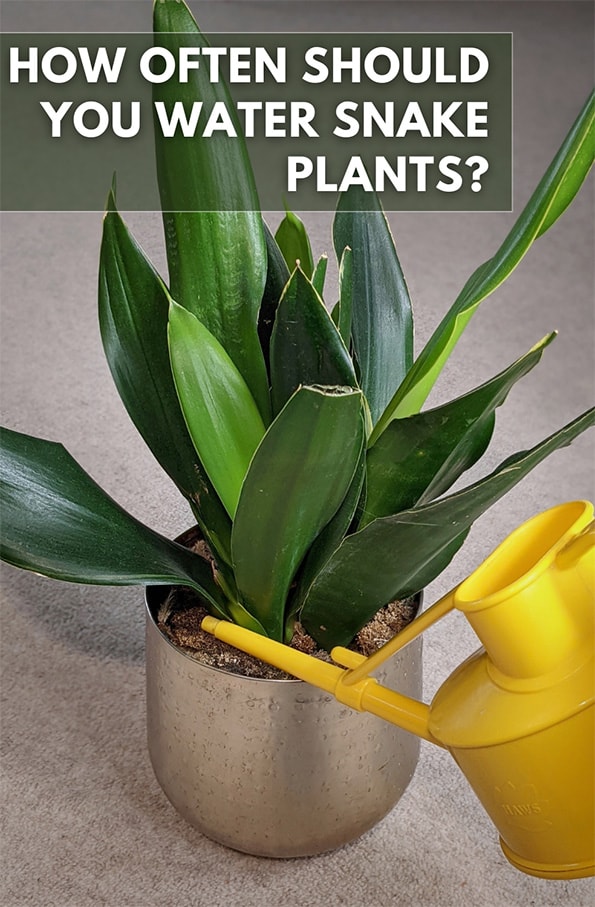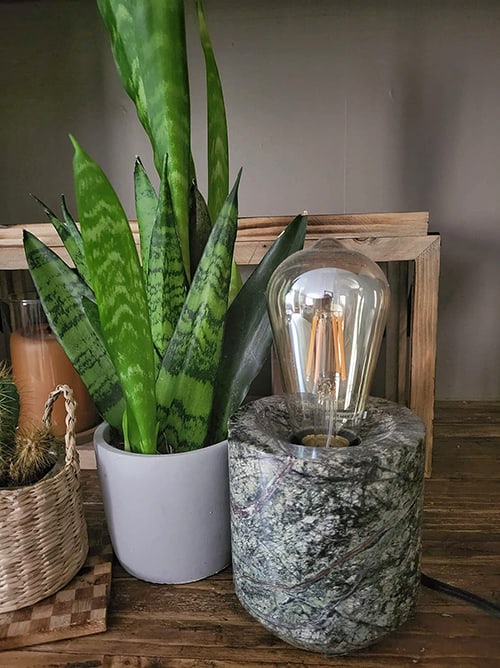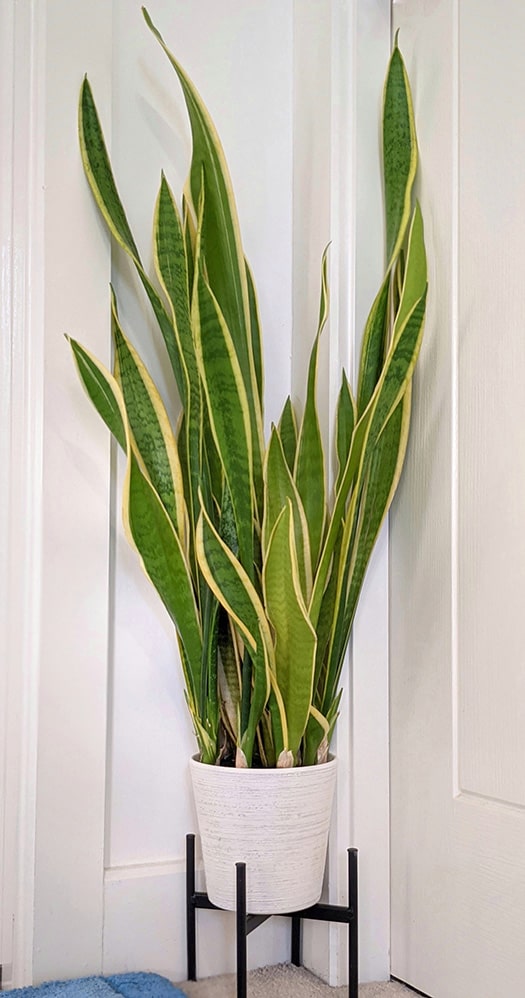Snake Plants (also known as Sansevieria or Dracaena) make for brilliant and easy houseplants that can live for decades as indoor plants.
One of the main reasons they don't make that long life span for some owners is down to being given too much water. Excess water in the potting medium almost always leads to root rot.
This post will guide you into helping you give your Snake Plant the Goldilocks amount of water.
Dracaena trifasciata ‘Black Diamond’ (also known as Sansevieria trifasciata) is one of many Snake Plant varieties. They're tough plants capable of growing in low light or direct sunlight.
As for how often you should water and what the correct watering requirements are. I would like to answer this question with a simple response like "they only need watering every two weeks" or "once a month is plenty". But this is too simplistic. This will still be too much water for some plants; for others, it might not be enough.
So here are all my pointers and guidance to help you get the watering right.

Hi, I'm Tom!
If you're like me and enjoy the challenge of growing houseplants and getting them to thrive, then Ourhouseplants can help. This website shares my knowledge and years of growing plants and provides (hopefully) helpful advice on properly caring for your indoor plant friends.
When working out how much water a Snake Plant needs, the most important thing to consider is your personal environmental and growing conditions.
They're unique to you. My conditions are different and this is why I can't tell you exactly "what's right".
Here are the primary factors that influence your Snake plant's watering needs. You don't need to know everything about them in loads of detail. Think of them like general rules worth following.
What's best, little and often, or a heavy deep watering less frequently? A cup full of water, or a large jug?
Conventional wisdom and what you'll find on any houseplant website, is they want heavy and infrequent watering. Pour water over the surface of the soil until water starts coming out of the pot’s drainage holes at the bottom.
But this is my website and what I write is based on my growing experiences. I have over 10 different varieties and one of my oldest houseplants is a Snake Plant. I don't water it heavily and infrequently and it's been in my collection for well over 20 years now.
Following conventional wisdom isn't the only way to go about watering these plants.
I also find that pouring on so much water, often creates soggy soil especially if its in a large pot. This just encourages common problems like the dreaded root rot and fungal infections.
So there are two main approaches you could take.
Watering frequency will depend on variables like how much light and the type of pot it's growing in. The frequency will also decrease in the winter months and increase in the summer months.
Both methods can work well and they each have advantages and disadvantages.
Most people will normally prefer one option over the other, although there will be times when you mix it up and that's fine. After all in their natural habitat the amount of water they get and when, is variable too.
Top Tip
Snake Plants will always experience more overwatering issues than underwatering. It's far better to give too little water than too much.
However it's worth pointing out that out in the wild, there is a tendency for there to be longer periods of no rain and some intervals of drought.
This means a period of drying out is almost always needed (and expected) by these plants.
This is the must follow golden rule when thinking about successfully raising a Snake Plant as an indoor houseplant.
Whichever option you tend to go for, all you have to really remember is that after watering you need to wait for the potting mix to dry out, either fully or almost fully.
Many plants from the Dracaena genus make great houseplants due to their tolerance of sparse watering. The Snake Plant goes one step further because it has powerful succulent traits such as those thick fleshy leaves.
I won't get too complex. All you need to know is that they can heavily regulate their water use when required and this means they're tough plants when it comes to lack of water around their roots.
Did You Know?
Sansevieria Plants also use the Crassulacean acid metabolism (CAM photosynthesis), which further reduces how much water they use. It's this type of photosynthesis that makes them one of the best bedroom plants.
Put all of this together and this is a houseplant that is very tolerant of underwatering. In fact they can cope for months on end without being watered.
It's worth pointing out that this kind of care will create a surviving rather than thriving plant, but it should demonstrate they're capable houseplants and would prefer underwatering over overwatering.
This mother-in-law’s tongue is growing in a windowless hallway. It barely needs watering, so I avoid following a watering schedule and just opt for infrequent waterings around once a month.
A good rule of thumb when it comes to watering frequency is to remember that while they do enjoy a good watering, they do then expect a period of time to dry out before more water arrives.
How long that "drying out period" lasts for will depend on the different factors of their growing conditions. Basically, it comes down to where you've chosen to put them in your home.
I've put together a little quiz for you which will then give you the drying out guidance for various growing situations and locations.
Thinking about how and where your Snake Plant is growing, tell me about the environmental conditions by answering the four questions below.
This is a rough guide based on some assumptions which I detail below. I can't cover every possibility, so use this in conjunction with what I've already taught you.
If you go to water and the potting medium is still moist, you should wait another week before checking again.
What type of light is your Snake Plant growing in?
How would you describe the daytime room temperature?
What time of year is it for you?
Thinking about the size of your plant and the container it's in.
Results will show here once you've answered all four questions above.
You can reset the quiz with the button above if you want to run it again for different Snake Plants in your collection.
The results are based on a few assumptions.
Here are some of the common questions I get asked. If I've missed something, drop your questions in the comments below, and I'll add them.
Is it better to Bottom Water or Top Water Snake Plants?
There are advantages and disadvantages to each method of watering. But neither option has to be stuck to exactly and in most cases, you can do what works for you.
If you want more information I have an article you might like to look at. Is it better to water plants from the bottom or the top?
How do I know if my Snake Plant needs water?
The main way to find out if your plant needs water is to have a feel of the soil, either with your finger or using a measuring device like a moisture meter.
You can also get familiar with the weight of the pot in your hands. Directly after watering it's going to be heavy. As time passes and the potting mixture dries out, the container is going to get lighter. After doing this a few times you'll get a sense of when it's time for more watering.
What does an overwatered Snake Plant look like?
Leaves falling over is a good indication of overwatering. Usually the plant is in the early stages of root rot. A gentle pull and the leaf will likely come out completely at the base of the plant.
Mushy or yellow leaves are a strong sign that root rot has set in. If this is happening you should head over to my how to fix root rot guide.
What does a thirsty Snake Plant look like?
Very underwatered Snake Plants often go slightly wrinkled or shriveled.
When growing in bright light or full sun the leaves will often look washed out. You'll notice the color gradually drains out of the leaves and you lose the vibrant green.
Sometimes the leaves will have white or yellow parts and this can be confused for overwatering. The difference here is that the leaves will be firmly attached and won't come away in your hands. The potting mix will also be completely dry. It's time to water your Snake Plant!


